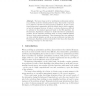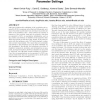76 search results - page 1 / 16 » Parameter Setting for Evolutionary Latent Class Clustering |
ISICA
2007
Springer
13 years 11 months ago
2007
Springer
The latent class model or multivariate multinomial mixture is a powerful model for clustering discrete data. This model is expected to be useful to represent non-homogeneous popula...
GECCO
2007
Springer
13 years 11 months ago
2007
Springer
This paper analyzes the scalability of the population size required in XCS to maintain niches that are infrequently activated. Facetwise models have been developed to predict the ...
AAAI
2011
12 years 4 months ago
2011
In this paper, we model the pair-wise similarities of a set of documents as a weighted network with a single cutoff parameter. Such a network can be thought of an ensemble of unwe...
PKDD
2009
Springer
13 years 11 months ago
2009
Springer
Co-clustering has emerged as an important technique for mining contingency data matrices. However, almost all existing coclustering algorithms are hard partitioning, assigning each...
NECO
2008
13 years 4 months ago
2008
One of the central problems in cognitive science is determining the mental representations that underlie human inferences. Solutions to this problem often rely on the analysis of ...


